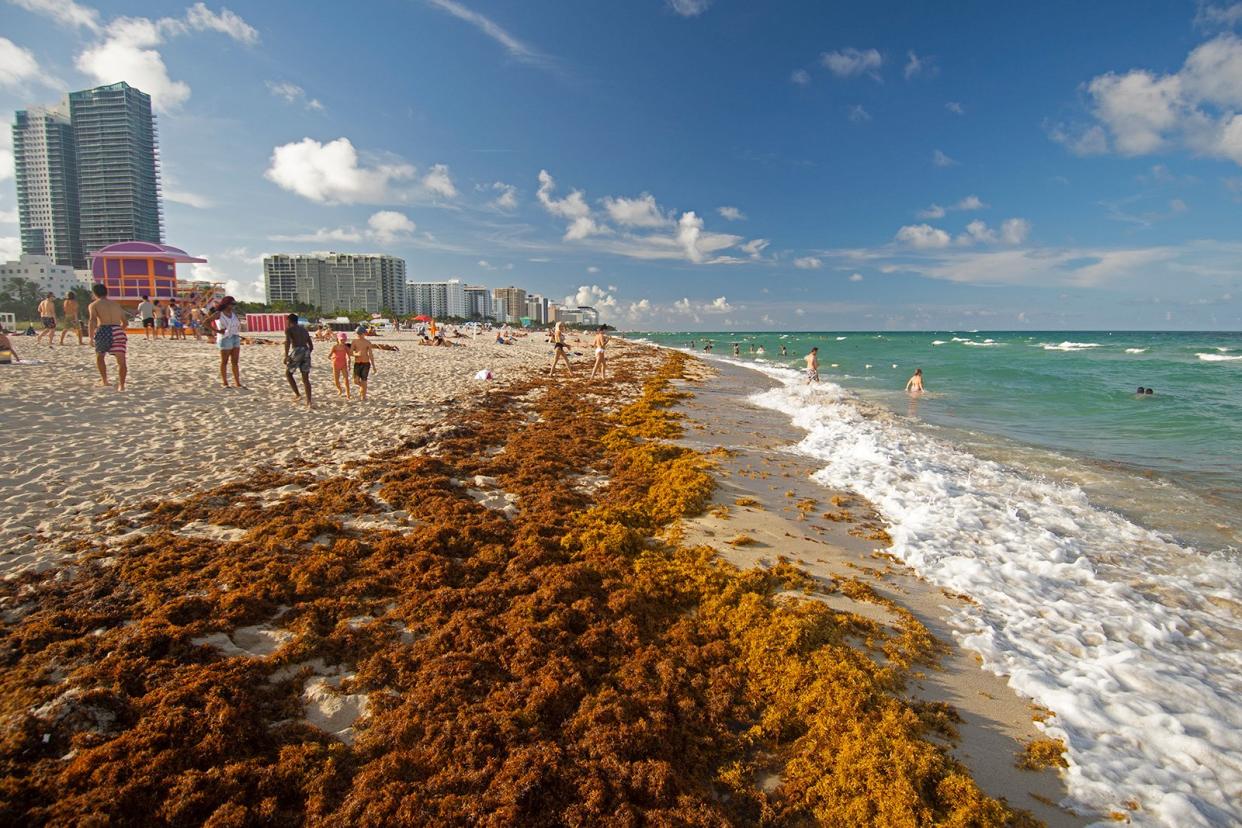5,000-Mile-Wide Seaweed Threatens Caribbean & Florida Beaches

(CNN) -- A gargantuan mass of seaweed that formed in the Atlantic Ocean is headed for the shores of Florida and other coastlines throughout the Gulf of Mexico, threatening to dump smelly and potentially dangerous heaps across beaches and put a big damper on tourist season.
The seaweed, a variety called sargassum, has long formed large blooms in the Atlantic, and scientists have been tracking massive accumulations since 2011. But this year's sargassum mass could be the largest on record — spanning more than 5,000 miles from the coast of Africa to the Gulf of Mexico.The blob is currently pushing west and will pass through the Caribbean and up into the Gulf of Mexico during the summer, with the seaweed expected to become prevalent on beaches in Florida around July, according to Dr. Brian Lapointe, a researcher at Florida Atlantic University's Harbor Branch Oceanographic Institute.
Lapointe said this year's sargassum bloom began to form early and doubled in size between December and January. The mass "was larger in January than it has ever been since this new region of sargassum growth began in 2011," Lapointe told CNN's Rosemary Church.
"This is an entirely new oceanographic phenomenon that is creating such a problem — really a catastrophic problem — for tourism in the Caribbean region where it piles up on beaches up to 5 or 6 feet deep," Lapointe added.
He noted that in Barbados, locals were using "1,600 dump trucks a day to clean the beaches of this seaweed to make it suitable for tourists and recreation on the beaches."
What is sargassum
Sargassum is a catch-all term that can be used to refer to more than 300 species of brown algae, although Sargassum natans and Sargassum fluitans are the two species most commonly found in the Atlantic.
The algae has its upsides when adrift at sea.
"This floating habitat provides food and protection for fishes, mammals, marine birds, crabs, and more," according to the Sargassum Information Hub website, which is a joint project among various research institutions. "It serves as a critical habitat for threatened loggerhead sea turtles and as a nursery area for a variety of commercially important fishes such as mahi mahi, jacks, and amberjacks."
The problems arise when sargassum hits the beaches, not only piling up in mounds that can be physically difficult to navigate but also emitting a gas that can smell like rotten eggs. And it can quickly turn from an asset to a threat to ocean life.
"It comes in in such a large quantities that it basically sucks the oxygen out of the water and creates what we refer to as dead zones," Lapointe said. "These are normally nursery habitats for fisheries ... and once they're devoid of oxygen, we have lost that habitat."
Sargassum can also be dangerous to human health, Lapointe noted. The gas that the rotting algae releases, hydrogen sulfide, is toxic, and it can cause respiratory problems. The seaweed itself also contains arsenic in its flesh, making it dangerous if ingested or used for fertilizer.
"You have to be very careful when you clean the beaches," he warned.
Mounds of algae dumped on beaches also cost millions of dollars to clean up, notes the Sargassum Information Hub.
Why 2023 has a sargassum problem
Just like plants and crops on the ground, the proliferation of seaweed can shift year to year depending on ecological factors, affected by changes in nutrients, rainfall and wind conditions, said Dr. Gustavo Jorge Goni, the director of the Physical Oceanography Division at the National Oceanic and Atmospheric Administration's Atlantic Oceanographic and Meteorological Laboratory.
Likewise, currents at sea can alter sargassum's annual growth and how much accumulates, Goni added. Phosphorus and nitrogen in the sea can also serve as food for the algae.
Those elements can be dumped into the ocean from rivers, which gain concentrations of phosphorus and nitrogen from human activities, such as agriculture and fossil fuel production, according to the Environmental Protection Agency.
For now, researchers are looking into ways to thwart its impact on beaches, possibly by sinking the seaweed to the bottom of the ocean or harvesting it for use in commercial products such as soap, Goni said.
Goni also cautions that research into these sargassum accumulations is new, and it's likely scientists' understanding of how the algae grows will shift over time.
"Whatever we believe we know today, it may change tomorrow," he said.
The-CNN-Wire
™ & © 2023 Cable News Network, Inc., a Warner Bros. Discovery Company. All rights reserved.


